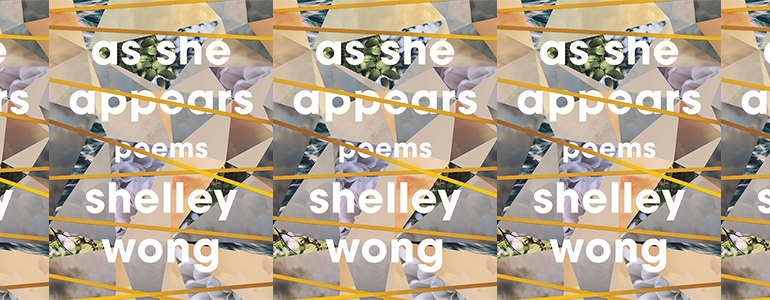“I wanted to write towards a kind of healing and recovery”: An Interview with Shelley Wong

The title of Shelley Wong’s debut poetry collection, As She Appears, out this week, exercises skepticism in the face of our most trusted sense: sight. If seeing is an act that inherently presupposes alterity—between subject and object, the beholder and the beheld—then Wong seeks an intimacy that exists beyond such binary models. She reaches toward a place where people can live a life of depth and multiplicity beyond appearance, a “hypergreen periphery” of plenitude and possibility where “any tree can become a ladder.”
As such, the spirit of her collection is vast and vigorous: a poem will ponder motherhood in nature on one page and embrace the ecstasy of Pride Festival celebrations on the next; through fashion, fairy tales, and Frida Kahlo, Wong creates an archive of the art and landscapes that have shaped her life with tenderness. The style of these poems is just as versatile. From couplets and monostiches to epistles and prose poems, Wong’s work is in a state of constant transformation, restlessly grappling with space on the page.
What ties As She Appears together is Wong’s eye for the environment and ear for music. Nature, in her hands, becomes inseparable from humanity and politics; she highlights the exacerbated ecological crisis of contemporary society, mentioning the Dakota Access Pipeline and rising sea levels. At the same time, there’s a Romantic sensibility threaded throughout the collection—she recognizes the restorative abilities of the environment, both physically and spiritually: “The tide calls the water / of the body.” Music, too, provides a sense of communion for Wong—especially pop music. “We all had the same Madonna-Whitney childhood / set to synthesizer beats,” the speaker says, charmingly earnest and exuberant, in “Weather Advisory.”
Where the collection ends, then, is in a place of indomitable gentleness. Despite the anxieties of climate change and capitalism that Wong tackles, she remains undeterred in preserving her personhood and agency: “To live, I want to be known & loved, the two together, inseparable.” In a world that always seems to find an aspect of one’s identity to degrade—whether that be gender, race, or sexuality—Wong holds on to every inch of soft power she has.
Austin Nguyen: True to its title, the poems in As She Appears reference vision in different ways: there’s the idea of sight and the gaze, and you mention film scenes and the camera, then in “Monolids” you have this fixation with the word “eyes.” What do you want readers to take away about what it means to be seen, especially in a culture where “being seen” is this shorthand for empathy?
Shelley Wong: That’s a huge question. I’m not sure if I have a purpose in what I want people to take away. But I think I wanted to convey the layered experience of being a queer Chinese American woman and—simultaneous to that—being an emerging poet, trying to figure out how to be a writer and an artist where there aren’t a lot of models or mentors in very hostile institutions from academia to artist institutions to journals. It’s all the tea!
But there’s so many layers that can feel oppressive in even just trying to be an artist all the way through. And you’re up against the larger culture, the larger society of systemic oppressions of women, LGBTQ folks, and Asians—especially now, we’re seeing it more visibly, but it was always there. So I think for me, I wanted to kind of convey these different histories and distortions and erasures and speak to how that can affect the psyche and self-consciousness.
I was thinking of “as she appears” in the misogynistic way of, “Oh, she’s not as nice as she appears” or “She’s not as good as she appears,” but instead changing it to being the moment she appears—she is a presence, she is no longer disappearing, she is appearing—and so, in that way, making it a statement of being and becoming in the world and about being seen.
AN: I’m glad that you mentioned this idea of erasure when you were talking about the title. One of the poems that really stuck out to me was “Private Collection,” where the speaker wanders the San Francisco Museum of Modern Art with their partner, noting how “no women resembled us.” One of the lines that I found humorous was this idea of pushing back and stating your presence defiantly: “Our hair in low ponytails / like George Washington.” How does representation, especially in places as culturally significant as museums, inform the ways we engage with ourselves and others?
SW: It’s another sphere of visual relation, whether it’s in books or film or in commercials. Museums are this verified space, similar to the literary canon, in providing visual images without language, which can be even more impactful depending on who’s looking at the painting, and how they’re receiving it. That enacts this silent transaction, so there is a kind of greater danger in letting those images speak without certain contexts. And I just think: As children going to museums, all of them are receiving these images in different ways, and maybe in distorted ways, and how that just becomes a continuum.
It’s interesting because I went to undergrad in ’98 to 2002. There were writers, poets of color, but not that many, and I went to Berkeley. I was often the only person of color, especially queer person, in my writing workshops. I really felt like I was waiting to find queer folks and people of color poets, which is why I waited to go to grad school. There’s such a disparity between women artists and male artists and also race and sexuality and that is changing too. But there’s a lot of disparity still. I think it definitely has an impact both in the public realm and also for artists in trying to navigate these spaces and institutions.
AN: Is there a queer or Asian canon of art that you were drawing from while writing? You have epigraphs from Muriel Rukeyser and Theresa Hak Kyung Cha, and I was reminded while reading of Jenny Xie, Justin Chin, and Arthur Sze.
SW: Part of my practice is building my own kind of queer Asian cannon. Going back to undergrad, Suji Kwock Kim’s Notes From the Divided Country was a huge influence, and the poem “Exit Strategist,” with the lines decentered, going back and forth, is based on her poem “Flight,” which uses the same lineation. She was a huge influence in terms of her expanse, bringing in history into this lyric narrative with visionary, epic qualities, and also thinking about craft and lineation in really creative ways. Also, I would say Eduardo Corral and Ocean Vuong because I think they also use the line and lyric and narrative in really inspiring ways. And also Sally Wen Mao, whose poem in Linebreak for Daul Kim, who was a South Korean supermodel who committed suicide—it’s called “Dirge with Cutlery and Furs.” It’s this lovely tender address to her on the runway, and it has this playful, mournful quality, which really struck my heart and also just amazed me. Like, Oh, we can write about South Korean supermodels, and so I think that she really inspired me to write about fashion, which is something I kind of dipped in when I lived in New York City. We can write about love for our Asian people, we can write about fashion, or about anything. She was the first Kundiman poet I’ve ever read, and so that kind of just opened up everything else, and it’s been amazing to see her career take off. Also Brenda Shaughnessy, especially Our Andromeda. I’m so fascinated by her crafts and also her brilliance with that humorous, sensual edge is really fascinating to me.
AN: Something I really loved about your poems is your use of pop culture. You mention pop singers like Whitney Houston and Madonna, actresses like Maggie Cheung in In the Mood for Love, the visual artist Frida Kahlo. Do you think the cultural touchstones that someone carries, like the ones you’ve included in your book, form their own language for intimacy?
SW: I like that. I will say that my former partner’s favorite movie is In the Mood for Love, so there’s definitely that resonance for me whenever I think about Maggie Cheung. I think that the art or music or songs that you love and you share with other people leave traces on you when you want to share it with your beloveds, whether they’re friends or partners or lovers. They’re kind of these markers of time, but also have resonances on how you experience emotion or act towards other people or are in the world. As a shy kid growing up and seeing Madonna, I think of her as my other mother. My mother is a Leo and Madonna’s a Leo and I’m a Leo, so I always think of her as my other Leo mother. It just kind of magnetized me and made me see the audacious recklessness, playfulness, centeredness of a woman and how women didn’t have to center a man. It was like the men had to be good enough for her and there could be so much play and transformation. Madonna also grew up in the suburbs of Detroit, so she was familiar with Frida Kahlo, and I think is often credited with popularizing Frida Kahlo because she purchased her paintings in the 90s. You see kind of the same echoes of self-portraiture and transformation and use of fashion and costume in Madonna as you do Frida. So when I started writing my Frida poems, it was like, Of course I love Frida because I love Madonna.
AN: Most of your poems work through lyrical observations, but there were a few that are structured almost like an epistle through apostrophe. “To Yellow” and “Dear Frida” come to mind as explicit examples, but also “Epithalamium” and “Invitation with Three Colors” almost. What was your intention in having these more direct addresses scattered throughout the collection?
SW: In my first year of graduate school, I took a playwriting class which I feel really opened up my writing and gave me greater confidence to do a direct address. I think I even inserted some poems like monologues because I needed more pages. But I think throughout the collection, and this is something my poet friend had observed, I don’t often have two people talking to each other. A lot of them are, like you say, either direct address or single speaker in meditation. For the direct address ones, especially “Dear Frida” and “To Yellow,” where they’re epistolary, there is that intimacy of a relationship over time or comfort and privacy and being able to talk about shared romantic history and relationship history that felt like the right space for that sort of disclosure.
AN: It’s impossible not to notice how nature is one of the main settings in this collection and how you draw on the environment not just as a source of beauty and transformation but also a source of contentious politics. What we see in nature is the product of what we choose to preserve and what we let die off. How do you reconcile nature’s capacity to provide solace—for us to be one with nature—and its potential to become weaponized?
SW: There’s so much of that simultaneity in so many spaces. Growing up in southern California and now spending a lot of my adulthood in northern California, California’s supposed to be paradise; everyone wants to be here and have some pleasure. Northern California is spectacularly panoramic, from Napa to Big Sur to San Francisco, but the climate crisis is happening and now fire season is year-round and we’re in this extreme drought. Now it’s everywhere, it’s all around the world. You hear about the Antarctic ice shelves melting and the weather having no seasons. That’s another kind of thread that has emerged in the book—the instability of weather and what we know. It’s a lot to hold at once, in terms of going into nature as kind of our refuge from people sometimes but also being aware so much of climate change and what is being preserved and how it’s being preserved and native versus non-native versus invasive species and all the emerging concerns that are happening in the ocean.
AN: Personifying nature is a literal undertaking in your poems. Trees are named queer, and in “To Yellow” you apostrophize the color to show the racial dimensions of nature’s political power. Do you view your poems as a way to approach how efforts towards environmentalism and racial equity go hand in hand?
SW: So much of the environmental destruction is because of corporate America, whether it’s in America or overseas. And as the climate crisis is happening, by 2045 America is going to switch over to being predominantly POCs. So just as POCs are becoming the majority, the world is collapsing. In thinking about who has the power to act in ways that preserve and heal and try to reverse all the incredible damage done to so many terrains and water sources, [they] are the same forces that are against [resolving] all the systemic problems which oppress and harm people of color.
AN: Another thing that sort of struck me about As She Appears is how a sense of quietude pervades your collection in different ways—the sections are divided by caesuras, and the dedication is made out to “the quiet sisters.” I’m also reminded of a line from “Monolids” where the speaker says, “Two women / glance at each other / in a field & no one // says sanctuary or belonging.” What do you want your readers to take away about silence and how it shapes relationships?
SW: In writing the book, I wanted to write towards a kind of healing and recovery. And that’s shown having many different landscapes: having physical space in order to have mental space and offering a space for clarity. I think that silence can be in that space of solitude or be between people as a space of comfort and intimacy. But there can also be the intimacy of unease or unwillingness or withholding or rupture. Especially for quiet women of color, silence can be a space of trying to contend with speaking and in what way they will navigate honesty and risk, sometimes the risk of honesty. That can be different for different people, but there’s certainly that charge in silence in trying to think through connections and risk connection.



